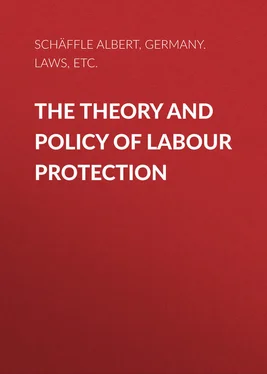Albert Schäffle - The Theory and Policy of Labour Protection
Здесь есть возможность читать онлайн «Albert Schäffle - The Theory and Policy of Labour Protection» — ознакомительный отрывок электронной книги совершенно бесплатно, а после прочтения отрывка купить полную версию. В некоторых случаях можно слушать аудио, скачать через торрент в формате fb2 и присутствует краткое содержание. Жанр: Юриспруденция, Юриспруденция, foreign_antique, foreign_prose, на английском языке. Описание произведения, (предисловие) а так же отзывы посетителей доступны на портале библиотеки ЛибКат.
- Название:The Theory and Policy of Labour Protection
- Автор:
- Жанр:
- Год:неизвестен
- ISBN:нет данных
- Рейтинг книги:5 / 5. Голосов: 1
-
Избранное:Добавить в избранное
- Отзывы:
-
Ваша оценка:
- 100
- 1
- 2
- 3
- 4
- 5
The Theory and Policy of Labour Protection: краткое содержание, описание и аннотация
Предлагаем к чтению аннотацию, описание, краткое содержание или предисловие (зависит от того, что написал сам автор книги «The Theory and Policy of Labour Protection»). Если вы не нашли необходимую информацию о книге — напишите в комментариях, мы постараемся отыскать её.
The Theory and Policy of Labour Protection — читать онлайн ознакомительный отрывок
Ниже представлен текст книги, разбитый по страницам. Система сохранения места последней прочитанной страницы, позволяет с удобством читать онлайн бесплатно книгу «The Theory and Policy of Labour Protection», без необходимости каждый раз заново искать на чём Вы остановились. Поставьте закладку, и сможете в любой момент перейти на страницу, на которой закончили чтение.
Интервал:
Закладка:
f. The work of a Factory is continuous, and g. Is carried on on a large scale, and with a large number of workpeople, hence ( f and g ) it may be compared to the quasi-factory business of class 2 ( supra ) for the purposes of a protective Code.
h. The work of a Factory is carried on in workplaces provided by the employer, not in the rooms of the workers or of a middleman.
i. The work of a Factory results in the immediate sale of the commodities produced, and does not consign them to the wholesale dealer to be prepared and dressed, or distributed by wholesale or retail, i. e. the Factory has absolute control of the sale of the commodities produced, in contradistinction to household industry.
Thus the Factory as understood by the German labour-protective laws is commercially independent (characteristic i ), industrial ( c ), carried on on a large scale ( g ), and continuously ( f ), in enclosed ( d ), specially appointed ( b ) work-rooms provided by the employer ( h ), with the help of power machinery ( e ), and by wage-workers not belonging to the family of the employer ( a ).
Purely hand-manufacturing wholesale business should also be counted as factory-labour; for the fact that workshop business carried on with the help of power machinery is declared to be on the same footing as factory-labour means only this: that it presupposes the same need of protection felt in factories where the business is carried on with the help of power machinery, as is the case in most factories; it does not mean that certain kinds of manufacturing wholesale business carried on without power machinery (of which there are very few) should not be counted as factories. We are therefore justified in dropping characteristic e of the theoretical conception of the Factory, as understood in Germany.
Let us now look at the Swiss Factory Regulations. The Confederate Factory Act of March 23, 1877, has given no legal definition of the word “Factory,” but only of “protected labour.” It extends protection to “any industrial institution in which a number of workmen are employed simultaneously and regularly in enclosed rooms outside their own dwellings.” According to the interpretation of the Bundesrath (Federal Council) “workers outside their dwellings” are those “whose work is carried on in special workrooms, and not in the dwelling rooms of the family itself, nor exclusively by members of one family.” Furthermore, all parts of the Factory in which preparatory work is carried on are subject to the Factory Act, as well as all kinds of printing establishments in which more than five workmen are employed. The Swiss Factory Act requires that a Factory shall possess all those characteristics assigned to it by German protective law, with the exception, however, of power machinery, and hence it doubtless covers all manufacturing business in which a number of workmen are employed.
According to Bütcher, 6 6 Cf. Conrad’s Encyclopædia , vol. i. p. 154.
in the practical application of factory-protection in the Confederate States, any industrial establishment is treated as a factory which employs more than twenty-five workers or more than five power-engines, in which poisonous ingredients or dangerous tools are used, in which women and young persons (under eighteen years) are employed (with the exception of mills employing more than two workers not belonging to the family), and sewing business carried on with the help of three or four machines not exclusively worked by members of the family.
In Great Britain the Factory and Workshop Acts of March 27, 1878, cover all factory labour, and the bulk of workshop business, i. e. all workshops which employ such persons as are protected by the Act – children, young persons, and women.
This English Act again furnishes no legal definition of the term. “According to the meaning of the term, implied in this Act,” says von Bojanowski, “we must understand by a factory any place in which steam, water, or other mechanical power is used to effect an industrial process, or as an aid thereto; by ‘workshop,’ on the other hand, we must understand any place in which a like purpose is effected without the help of such power; in neither group is any distinction to be drawn between work in open and in enclosed places.”
Under this Act factories are divided into textile and non-textile factories. “ Workshops are divided into workshops generally, i. e. those in which protected persons of all kinds are employed (children, young persons, and women), with the further subdivisions of specified and non-specified establishments; into workshops in which only women, but no children or young persons are employed; and lastly, domestic workrooms in which a dwelling-room serves as the place of work, in which no motive power is required, and in which members of the family exclusively are employed.”
Domestic work-rooms in which only women are employed do not come under the Act, nor yet factories, such as those for the breaking of flax, which employ only female labour. Bakeries are included among regulated workshops, i. e. workshops inspected under the Factory Acts, even when no women or young persons are employed. The Factory, as understood by the English law, is distinguished by most of the characteristics of the German acceptation of the term, without however admitting of the distinction of class d (business carried on in an enclosed space), whereby protection is also afforded to what we have termed quasi-factory labour (see p. 36); but on the other hand a special point is made of the distinction of class e , viz. use of power machinery. Thus the English idea in defining the factory is to insist, not upon the number of persons employed, but upon the proviso that they are persons within the scope of the protective laws.
In the von Berlepsch Bill this is dealt with side by side with factory labour. It is sometimes placed on the same footing under the various categories of quasi-factory labour (classes 3 and 4), sometimes it lies outside the limits of factory protection, in cases where the Bundesrath does not exercise his privilege of granting extension of protection, and in cases where the workshop in question is worked entirely by members of one family.
It would be tautology to include in the definition of the workshop all the characteristics of the factory named in classes a to i . There may be cases in which the workshop practically includes most of the characteristics of the factory, but it is only necessary that it should include the following: business carried on outside the dwelling-rooms ( b ); preparation and manufacture of commodities ( c ); carried on in enclosed places ( d ). With the other classes it is not concerned. According to the English Factory Acts protected workshop labour is not necessarily carried on in enclosed places.
In treating of German workshop labour for the purposes of the von Berlepsch Bill, and for future legislation of the same kind, we have to classify it as follows:
Workshop labour carried on with the help of power-machinery, but not otherwise answering to the conditions of the factory.
Workshop labour carried on without power-machinery, by hand or by hand-worked machines.
Labour in workshops where all three kinds are required, i. e. power-machinery, hand-work, and hand-worked machines ( e. g. modern costume-making in which power sewing-machines are employed.)
The old handicraft labour carried on in special workrooms, either within or outside the dwelling of the worker.
Читать дальшеИнтервал:
Закладка:
Похожие книги на «The Theory and Policy of Labour Protection»
Представляем Вашему вниманию похожие книги на «The Theory and Policy of Labour Protection» списком для выбора. Мы отобрали схожую по названию и смыслу литературу в надежде предоставить читателям больше вариантов отыскать новые, интересные, ещё непрочитанные произведения.
Обсуждение, отзывы о книге «The Theory and Policy of Labour Protection» и просто собственные мнения читателей. Оставьте ваши комментарии, напишите, что Вы думаете о произведении, его смысле или главных героях. Укажите что конкретно понравилось, а что нет, и почему Вы так считаете.












![Edward Ellis - Adrift on the Pacific - A Boys [sic] Story of the Sea and its Perils](/books/753342/edward-ellis-adrift-on-the-pacific-a-boys-sic-s-thumb.webp)